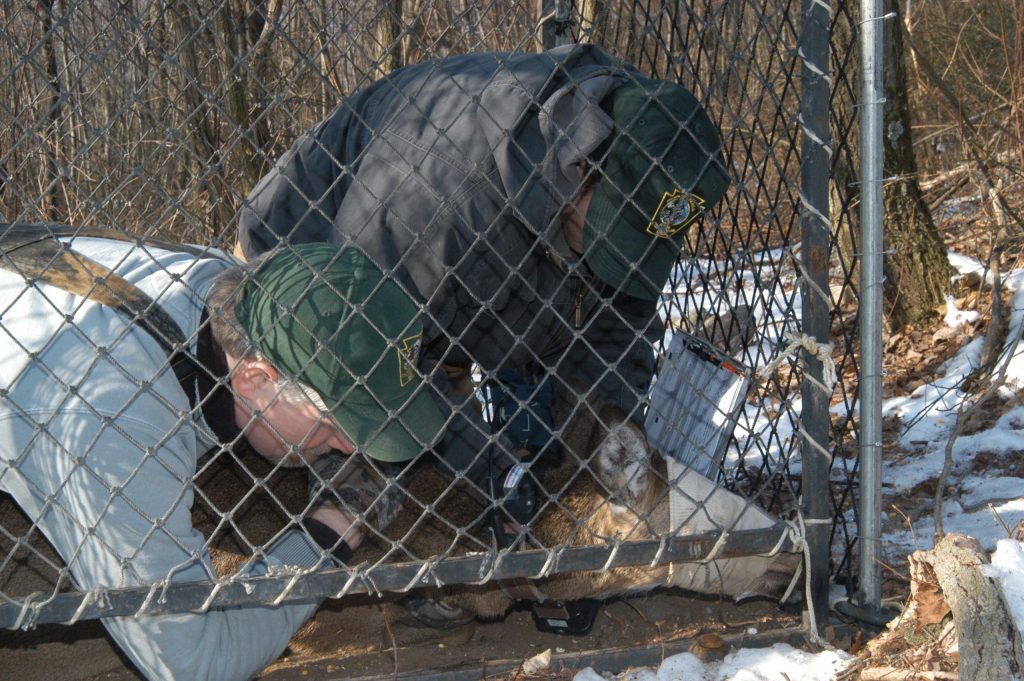Ever since I earned my degree in wildlife management, the trapping and transferring deer has been proposed as a solution to having deer in the right place. Trap-and-transfer is a valid technique for restoring wildlife populations (it was done a hundred years ago to restore the white-tailed deer throughout North America). Why can’t it be used to redistribute deer today?
But first, let me be clear. The purpose of this blog is to share information about deer. Not opinions. So what I am about to write here are insights into trapping deer based on my experience and transferring deer (based on what others have learned). I will let the reader decide whether trap-and-transfer could be useful to solve a specific problem.
First of all, in Pennsylvania we have a lot of experience trapping deer (literally thousands over the past 15 years).
When we began trapping in 2002, we reviewed the literature and found that capture mortality rates were highly variable. Researchers in New York published a review of deer capture methods and found that capture-related mortality rates varied from 2% to 21%. Given the time and effort needed to capture a deer and its value as a study animal, having 1 in 5 deer die as a result of capture would not be good.
Fortunately, we have found that our overall capture-related mortality rates are about 4% using Clover traps, rocket nets, and drop nets.
Over the years, we have refined our trapping techniques. For example, we made the trigger mechanism on our Clover traps to include a “break-away” design so that if deer did try to escape they were less likely to hurt themselves even though Clover trap injuries are rare. Also, when we capture deer in rocket nets we sedate them to minimize stress. And we have a reversal drug so that they can quickly recover and be on their way.
If we are so good at capturing deer and minimizing mortality, why can’t we trap and transfer deer from where we don’t want them to where we want more? If it were only that simple.
First of all, the deer we capture in Clover traps may be released in less than 2 minutes (if all they receive are ear tags). Regardless of the trapping method, deer are released at the capture site in a short period of time (minutes in most cases).
What if we were to transfer deer to another part of Pennsylvania? It’s a big state.
- Scranton to Coudersport area in Potter County – 157 miles, 3.5 hr drive
- Valley Forge to Milroy area in Mifflin County – 151 miles, 2.5 hr drive
- Pittsburgh to Kane area in McKean County – 127 miles, 2.5 hr drive
Second, what is required to keep a deer safe and healthy, while sedated and traveling in a vehicle for 2-3 hours? A lot. Deer can get what is called “bloat” because they have a rumen (just like a cow). If they are sedated it is difficult for them to “burp” and gasses can build up. That can be fatal.
Also, while sedated it is more difficult for animals to self-regulate their temperature. Depending on the temperature, they can quickly overheat or succumb to hypothermia.
What would be the capture mortality rate of capturing deer and transporting them 2-3 hours across Pennsylvania? I do not know, but I am sure it would be higher than 4%.
Third, what do those deer do when they wake up after a 3-hr car ride? And where do they go? You can only catch deer in winter – the most difficult time of year for deer. A released deer will now have to figure out where to find food. It will have to figure out where to find cover when the snow gets deep (if it isn’t already) and the temperature drops (if it isn’t already cold).
And how will the deer know the best route to escape predators?
So what would the mortality rate be for deer captured in Valley Forge and transported to central Pennsylvania and released? I’m sure it would be higher than 4%.
It costs the Deer-Forest Study about $1,000 to capture a deer and release it at the capture site.
What would it cost to capture, transport, and release a deer? And have it survive to the following hunting season? Probably much more than $1,000 (that alone is equal to the revenue from 50 hunting licenses).
Finally, we have chronic wasting disease in Pennsylvania. Do we want to risk spreading CWD? Unfortunately, that is no longer a hypothetical concern.
So all of these issues must be considered when trap-and-transfer is proposed as a solution to a problem.
Based on these facts, what do you think?
-Duane Diefenbach
You can subscribe via email for updates to the Deer-Forest Blog.
And Follow us on Twitter @WTDresearch
